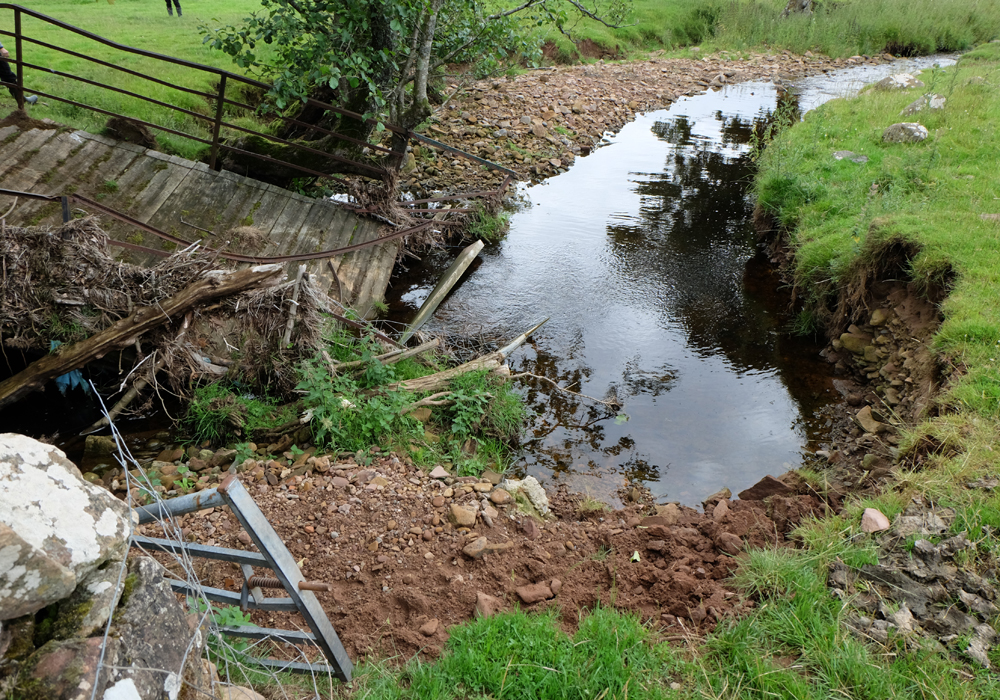I went to Culroy Burn on the Doon this evening to see how our green engineering and restoration attempts were faring. It has been 3 years since we finished the section at Blackbyres and 2 since we completed the Sauchrie restoration.

Blackbyres erosion prior to the restoration works

The site near Sauchrie where we removed barriers to reduce erosion and then fenced. This image was taken looking upstream
Both areas were fenced with generous support from the Doon DSFB. Culroy Burn was not unique in having severe erosion problems but ART identified it was a priority for restoration within the Doon catchment. The Blackbyres site had severe erosion taking place on the outside of a tight bend. The landowner was losing ground in every spate. Fine sediments coated the burn and it was in poor condition along its length as tonnes of soil were lost to the burn each year. After securing agreements from landowner and Board, ART staff set about restoration. Look back through our blog for previous posts detailing the work done and our successes and failures too. There’s a good pictorial record.

Another image of the upper site at Blackbyres that shows the scale of the problem well. The bank was approximately 4′ above the water level.

The lower Blackbyres site where there were obvious problems
we regraded the sheer 4′ high banks that were continually eroding with every spate. The new bank was seeded and then willow spiling followed by stock proof fencing were installed. At the end of the year we planted a few hardwood trees. Today the willow spiling was looking great and is protecting the bank from further erosion. It will be due for partial coppicing soon and this serves two purposes; it provides more material for further restorative attempts elsewhere and it also encourages the plants to bush more. We may delay harvest until the spring of next year unless we have urgent need for materials.

Willow spiling has performed well and these plants would now benefit from a degree of coppicing. Erosion has been halted.

The lower Blackbyres site today. Compare this with the previous image above of the same location. Things are looking much more promising in this stretch of the burn these days. Young trees are doing well although perhaps we could do with a few more. We’ve plenty grown in our own nursery ready to plant out this winter.
Deer have been a problem for some trees but we expected as much and can plant a few more this winter. If we can fund tree guards, these would help tremendously but there are trees surviving and doing well. However, few more would be beneficial.

The site near Sauchrie in the upper reaches of Culroy Burn as we were about to commence work in June 2017

There were multiple issues on site and all leading to water quality issues

Livestock access was the main factor leading to poor water and habitat quality. The obvious solution had to include fencing if we were to achieve anything.

A ford in the centre of the site. We regraded this area to ensure there were no gaps for lambs to sneak under our fencing
Sauchrie also has been transformed from the over wide and shallow trickle that was always coated with fine sediment and cow pats. The cattle were excluded, a redundant weir removed and then fencing erected. Since then we’ve also planted native trees which again are doing ok but we may plant more this winter. Hares and deer are a constant threat to developing trees but they never eat them all. The burn has narrowed as te banks have revegetated and the bed has cut down following the removal of an ancient and redundant weir. In time, the burn should be able to retain water year round rather than drying out as it does during drought periods. This may still take time to achieve but everything is heading the right way. Just downstream in the Otterden woods, he burn always retains water due to the bedrock and shade provided and there’s a decent trout and sea trout population. Eventually it would be nice to think we will find juvenile trout and salmon in the restored stretch too. The last salmon we found here was a juvenile in 2012.

The upper end of the Sauchrie site where we removed a collapsed bridge and immediately cut erosion. The bridge was situated at the end of the wall to the left of the image

Immediately after fencing and removing a redundant weir, the banks revegetated and the bed of the burn started to cut down as it found its new level. The result is a narrower and hopefully eventually, a deeper burn.
A major benefit of this work has been that lower beats on the River Doon now report that the river clears at least one and half to two hours sooner following a spate, than before we tackled these issues. The Culroy itself is much much cleaner and if ever any salmon spawn there, I’m certain egg survival will have improved. With the last agricultural beat recently fenced in the lower reaches of this burn, we expect considerable improvements in time. There’s no doubt that it is an important trout spawning area but we really would like to see salmon return in greater numbers.

A much more pleasing sight than the over grazed and eroding habitat of just 2 years ago
Both these sites had multiple and severe issues. It’s reassuring that things can turn around quickly using a few simple techniques and an understanding of how to apply them. ART are grateful to the Board for their financial contribution towards the costs of the fencing and works. It would not have been possible without their support.

